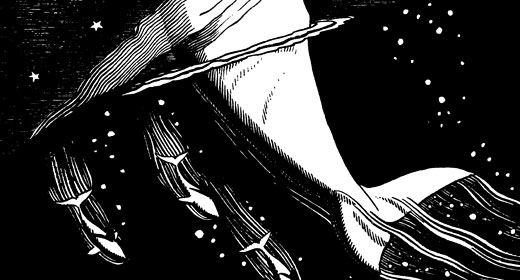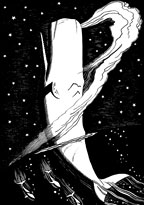
The Big Book About the Big Whale
A chapter on whales. A chapter on white. A short story dropped in the middle. And a plot line involving a crazy man chasing a gigantic, oddly hued mammal. Why bother?
By Ruth Alden Doan
 Every year Sowell funds support faculty from a variety of disciplines who work together to enhance the understanding and teaching of the liberal arts. Last fall a Sowell grant underwrote the opportunity to gather a few historians, a couple of English professors, a physicist, two classicists, a communication studies professor, and a smattering of others—all to the end of reading the big book about the big whale.
Every year Sowell funds support faculty from a variety of disciplines who work together to enhance the understanding and teaching of the liberal arts. Last fall a Sowell grant underwrote the opportunity to gather a few historians, a couple of English professors, a physicist, two classicists, a communication studies professor, and a smattering of others—all to the end of reading the big book about the big whale.
On one level, this kind of reading group could benefit members of the faculty even if we chose to read nothing but the Sunday funnies. To see each other bringing our own perspectives to bear on a single source helps us all to appreciate that variety of perspectives. To read together builds cohesion among the faculty. To have an assignment reminds us what students face!
But we did not choose the Sunday funnies. We chose Herman Melville’s Moby-Dick. Not a popular success in the 1850s, Melville’s famous work has become a touchstone of popular culture. When we hear “Ahab,” we do not think “Old Testament,” but instead imagine a monomaniacal sea captain. Many Americans can quote the famous opening line, “Call me Ishmael,” even if they have never opened the book. Shouldn’t those who teach in the liberal arts look behind the popular culture standards to the sources of some of our long-lasting myths?
Moreover, Moby-Dick speaks to the American experience in complex if incomplete ways. The ship Pequod brings together in a single pursuit people from a variety of places and cultures: Starbuck the Nantucket Quaker, Tashtego the Native American, Daggoo from Africa, the Parsi Fedallah, and the wonderful Queequeg, harponeer of South Pacific island birth, worshiper of his own idol, cannibal, and walking work of tattoo art. Not only does the Pequod teem with cultural diversity, but also Melville wrestles with questions of cultural superiority, inferiority, and relativity. What are we to make of the assertion that Queequeg is “George Washington cannibalistically developed,” or of Ishmael’s prayer: “Heaven have mercy on us all—Presbyterians and Pagans alike—for we are all somehow dreadfully cracked about the head, and sadly need mending.” But for all of the diversity of the Pequod, for all that Ishmael asserts that everyone belongs to “the great and everlasting First Congregation of the whole worshipping world,” the women stay at home or in the world of metaphor. Real women do not sail on the Pequod.
Maybe Moby-Dick also shows a master at work, drawing on literary models, incorporating a vast array of research, and writing sentences that sing. Shakespearean-style soliloquies break into the story. Types of whales, processes for butchering whales, and philosophical meanderings are all on offer to the reader. And Melville, at his best, knows how to write.
Members of our reading group disagree on whether Melville’s digressions amount to a remarkable artistry or whether he just needed a good editor. We tend to agree, nonetheless, that there are gems in Melville:
Old age is always wakeful; as if, the longer linked with life, the less man has to do with aught that looks like death.
That Melville can jab us with insight:
Exception may be taken to the name bestowed upon this [the killer] whale, on the ground of indistinctiveness. For we are all killers, on land and on sea; Bonapartes and sharks included.
And that he can reduce us to side-splitting laughter, as he does in the scene in which Ishmael and Queequeg become roommates (but you will just have to read it to see).
Is it The Great American Novel? Nathaniel Philbrick has called Moby-Dick “our American Bible” in his recent Why Read Moby-Dick? But most professors shy away from the whole question of “the greatest.” We are content to sail away on the Pequod and let Melville carry us where he may.
Professor of History Ruth Alden Doan primarily teaches courses in early America and social and religious history. Other members of the Moby-Dick reading group included Joe W. Leedom (history), Peter Coogan (history), Jeanne Larsen (English), Julie Pfeiffer (English), George Ledger (psychology), Marshall Bartlett (physics) Fred Franko (classics), Christina Salowey (classics), Chris Richter (communication studies), Anna Goodwin (registrar), and Keith Humphry (adjunct faculty, communication studies).
Illustration credit: Illustration by Rockwell Kent. Courtesy of Plattsburgh State Art Museum, Rockwell Kent Gallery & Collection.
